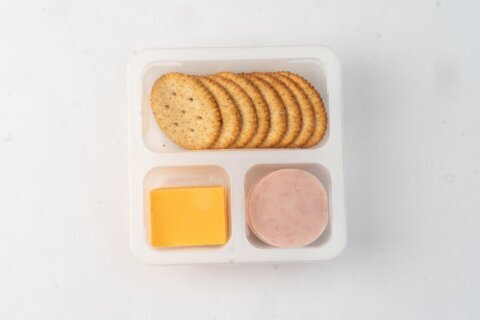On the fourth of July, it’s all about red, white and blue — and food is no exception. Naturally colored red, white and blue foods make for some of the most delicious summertime dishes, and they’re filled with good-for-you nutrients to help keep your body healthy and happy.
Red
Tomatoes
The season of tomatoes has arrived! These babies come in all sizes and shapes — check them out on your next visit to your local farmers’ market. One medium tomato has about 25 calories, 1 gram of fiber and 3 grams of sugar. They’re an excellent source of antioxidant vitamins A and C providing 20 percent and 26 percent of your daily recommended amount, respectively. Tomatoes are also high in the powerful antioxidant lycopene, which gives tomatoes it’s gorgeous red hue. Lycopene has been shown to help reduce the risk of heart disease and cancer.
There are so many ways to add tomatoes to your dishes. But if you’re going to slice them as a pizza topping or into a salad, choose the seedless varieties, such as roma or plum.
Storage tip: Store tomatoes at room temperature, not in your refrigerator, which can make them mealy.
Strawberries
Ninety percent of American-grown strawberries are from California. Eight medium strawberries contain 45 calories and 12 percent of your daily recommended amount of fiber. These red gems also contain more vitamin C than an orange, providing 130 percent of your daily recommended dose. Recent studies have shown that eating strawberries every day can help reduce risk factors for diabetes, including lowering levels of insulin resistance. Further, a 2013 study published in Circulation found that eating more than three weekly servings of strawberries, which are high in the plant chemical anthocyanin, can help lower the risk of heart attacks.
Munch on fresh strawberries as a snack, enjoy on top of a fruit pizza, over a bed of spinach or blended and frozen into popsicles.
Preparation tip: Wash strawberries right before eating or using.
Watermelon
This juicy relative to cucumbers, squash and pumpkins is 92 percent water. It’s also a good source of the antioxidants beta-carotene and vitamin C. Like tomatoes, watermelon also contains lycopene. One cup of watermelon contains the same amount of this power antioxidant as two medium tomatoes. Although studies have shown the potency of lycopene is enhanced when cooking tomatoes, the same doesn’t hold true for watermelon. You can enjoy the power of this plant chemical by eating fresh watermelon.
Sinking your teeth into a juicy slice or watermelon is one way to relish watermelon. You can also combine it with mint and feta for a refreshing salad, or whip up a watermelon granita.
Preparation tip: Wash the outside of the watermelon with a stiff bristled brush to remove the dirt before slicing it open.
White
Mushrooms
Although they’re categorized as a veggie, mushrooms are actually a fungus. There are thousands of varieties available, but the white capped are readily available and will help keep with your patriotic theme. Mushrooms are relatively low in calories, with one sliced cup providing 20 calories and a boatload of nutrients, such as folate, thiamine, vitamin B6 and zinc. Mushrooms also contain an antioxidant called L-ergothioneine, which has been shown to help protect your liver and kidneys.
Top a margarita pizza with mushrooms (that’s red and white!), or create a chopped salad parfait with tomatoes, mushrooms and purple cabbage.
Shopping tip: Choose fresh mushrooms that are firm and evenly colored. Avoid those that are damaged or have soft spots. Store unwashed mushrooms in a paper bag in the refrigerators for up to five days.
Cauliflower
One cup of this raw vegetable has 25 calories, 10 percent of your daily recommended amount of fiber and lesser amounts of vitamins C, K, B6 and folate. Cauliflower is a member of the cruciferous veggie family (aka cabbage family), and contains several potent cancer-protecting antioxidants, such as glucosinolates, sulforaphanes and thiocynates.
Toss raw chunks of cauliflower in a salad, or make it part of a colorful veggie platter. You can also roast cauliflower or grill large slices for a delightful vegetarian “steak.”
Shopping tip: Choose cauliflower heads that are firm and brightly colored. Store with the stem side up in the refrigerator for up to one week.
Choose heads that are firm, compact and brightly colored. Store stem side up in the refrigerator drawer for five to seven days.
Blue
Blueberries
One blueberry bush can produce as many as 6,000 blueberries a year. A cup of these round berries have about 84 calories, 4 grams of fiber and are an excellent source of vitamins C and K. They’re also brimming with anthocyanidins, an antioxidant found in foods with a blue and red hue, which may protect against glaucoma and prostate cancer.
Toss a handful of blueberries onto a spinach salad for tanginess, or make a trifle with strawberries, blueberries and a touch of homemade whipped cream.
Shopping tip: Choose blueberries that are firm and brightly colored. Lightly shake the container to check if the berries are moving freely and aren’t stuck to the bottom.
Eggplants
Part of the nightshade family, along with peppers, potatoes and tomatoes, eggplants resemble an egg shape (hence the name). Eggplants grow on vines and can be found in a variety of shapes, sizes and colors, with the most common color being purple. One cup of eggplant cubed has 20 calories, 3 grams of fiber and 5 percent of your recommended daily amount of potassium and folate. They’re brimming with the plant chemicals chlorogenic acid and caffeic acid, which have been linked to cancer protection.
Grill, steam or sauté eggplants, or roast and puree into babaganoush. Top pizza with roasted eggplant, or add to a pasta salad with tomatoes (there’s your red, white and blue).
Shopping tip: Select eggplants that are firm, shiny and heavy for their size. Look for green stems, and make sure the flesh springs back to your touch. Avoid those that are dull in color, have brown or soft spots or have wrinkled skin.
More from U.S. News
Red, White and Blue Nutritious Fourth of July Foods
Eat Your Red, White and Blue — It’s Good for You originally appeared on usnews.com







